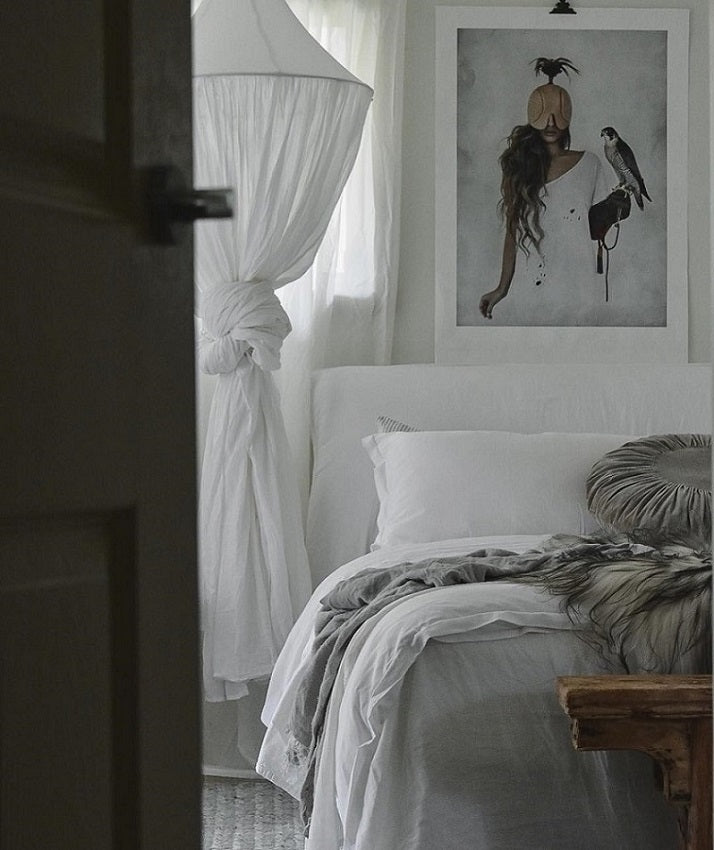
The design of every room in your home is important, but it’s especially critical to get the design right in the bedroom.
A study by the Sleep Health Foundation – “Australia is in the grip of a sleep deprivation epidemic that is dragging down the nation’s productivity, risking safety and damaging mental health, a national sleep study reveals.”
Creating a restful, restorative sanctuary can support a better night’s sleep that will help prepare you for the day has become more than décor, it’s is a matter of health and good sleep hygiene.
When designing a bedroom, it’s important to focus on colour, airflow, and furniture placement.
Experts say that at night bedrooms should be your cave, think; cool, dark, and quiet.
Consider these essential tips when designing the ultimate sleep haven:
PAINT WALLS A SOOTHING COLOR
Bold, bright colours can be visually appealing, but they are often too stimulating to have in the bedroom. A bright red is energizing, and purple is so mentally stimulating it may provoke nightmares. These colours aren’t good choices for a bedroom. The colour blue is said to be relaxing and soothing and can discourage nightmares. In fact, blue is the best sleep inducing colour for bedroom walls, so a light blue is a great choice for any bedroom. Light pastels, soft greys and neutral tones are also great for promoting a calming energy in your bedroom.
LEAVE ROOM FOR AIRFLOW
Hot, heavy, stagnant air isn’t helpful for sleep. Cool, openly flowing air is best for sleep, allowing you to rest at a cool temperature and enjoy the fresh air at night. Even if you’re working with a small bedroom, make sure you’re leaving room in between furniture for adequate walkways and airflow. Leave plenty of space between your mattress and the wall and separate your bed from other large furniture pieces. Using a fan can help encourage better airflow throughout your bedroom. A powerful overhead fan is best, but a fan in the corner of the room is a good choice, too. If weather and security are not a problem, it’s a good idea to open windows and doors to ventilate you bedroom and keep the air fresh.

BLOCK OUT THE LIGHT
At night, light is detrimental to sleep. Light is a powerful cue for your circadian rhythm, so when you’re exposed to light at night, your brain gets a signal that it’s daytime, and therefore time to wake up and be alert — even when in reality, it’s time to get to sleep. It’s a good idea to dim the lights in the evenings and avoid screen time at least one hour before bed. In your bedroom decor, you can use blackout curtains, which will block most of the light from windows. If you have blinds, the addition of Blackout curtains that can be closed at night, and then opened during the day to let light in when your body benefits from exposure to light.
TURN DOWN THE VOLUME
In today’s busy lifestyles we live with the constant buzz of life and media. There is always a noise or other distraction, and although this is unavoidable in most instances of daily life, it’s important not to let the volume of the day reach your bedroom. Your sleep environment should be a quiet, calming sanctuary. Encourage quiet hours in your home, asking family members to keep it down when others are sleeping or winding down into a bedtime routine. Shut your door to keep noise out as well. The fan you use to keep your room cool can help with white noise, or you can use a white noise machine to block out distracting sounds.
BED DOWN WITH COMFORTABLE BEDDING
Getting into a bed that is clean and well made adds to the feeling of calm, which aids good sleep. If your sheets are worn or frayed, it’s time to replace them. Choose good quality ones in a colour or pattern that you find calming and comforting. A beautiful soft grey will not only look good but be soothing and prepare you for sleep!
Sleeping with natural fibre such as bamboo, linen or cotton are best because they allow your skin to breath, bedding made from bamboo is also super soft and perfect for those with sensitive skin.
The same goes for your blankets, quilts, and duvet cover, choose natural fibers that are comfortable to sleep with. Your pillowslip is also important, this is where you lay your weary head! Natural fibers, bamboo, cotton and good quality linen that don’t irritate the skin are essential for a good night’s sleep and morning complexion!
In sleep studies, more than three quarters of people also believe that the comfortable feel of sheets and bedding are important to a good night's rest, and 62% said that a clean bedroom makes a difference. People who reported making their bed in the morning were 19% more likely to get a good night's sleep every night. It's not clear why this is, but perhaps there is a connection between feeling good about where you sleep and your tendency to sleep through the night.
CLEAR THE CLUTTER
Another distraction is clutter, which can make you feel anxious. Anxiety is not a quality you want to encourage anywhere in design, but it’s especially something to avoid in the bedroom. Make sure you’re clearing clutter from your bedroom, including piles of clothing, cords, devices and excessive knick knacks. Design your space to radiate rest and relaxation by including clever storage for your stuff and keep surfaces as clear as possible. After all, a more peaceful space will lead to deeper and more restorative sleep.
Give these simple tips a try as part of your sleep routine. You have nothing to loose, and maybe you will sleep deeper with the added bonus of sweet dreams!



Leave a comment